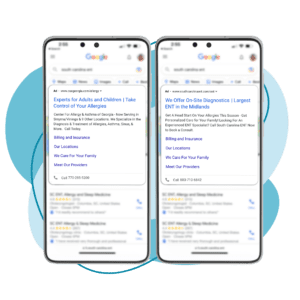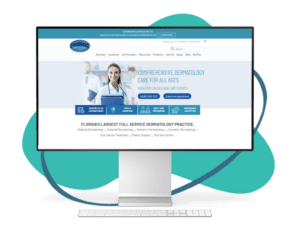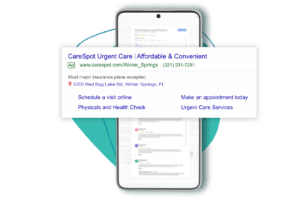What is at the heart of any Google PPC strategy? Your ad copy. Getting this right means having relevant, quality copy with a solid call to action (CTA) that provides supportive information to those seeking immediate answers.
While PPC advertising is one of the fastest methods to increase new patient volume and revenue, your Google Ads won’t perform well or attract the right people if your copy doesn’t align with patient motivations and goals. Ad copy is absolutely crucial to a campaign’s performance, and you can’t afford to overlook it.
How can you get your PPC ad copy up to scratch? Here are seven best practices to ensure your healthcare PPC ads convert your leads into new patients.
1. Speak to Your Target Audience
Your ad copy should be for one “person” and one person only—your patient. Make sure you place your patients at the heart of your messaging strategy.
What does this mean? You want your ad copy to address patient queries and needs, for one. Too often, healthcare marketers or copywriters think about their service first (and why it is so great) instead of thinking about the target audience and the problems they are trying to solve.
Start by thinking about what you’re asking your patients to do. What does your patient care about the most? There are several things you can focus on:
- Motivation: Is there something you can’t change but can tap into to compel your patients?
- Value props: Why should your ideal patient choose you? Appeal, exclusivity, credibility, clarity?
- Removing anxiety: What prevents people from seeking care? What specific info can you provide to negate these anxieties?
By tailoring your ad copy to these finer points, you can better target your ideal audience and increase conversions.
2. Ensure Your Ad Matches Your Keyword Intent
Take note: Google will only serve an ad if it matches the user’s search intent and answers the search query. You need to ensure that your ad copy is properly aligned.
What exactly is the intent of the main keywords in your ad group? Generally speaking, your keywords will either relate to proximity and/or convenience or an exploratory process.
If users are typing in ‘vet near me,’ proximity/convenience is the issue. As such, we should create ad copy that focuses on that. The query is solution aware and more transactional in nature, too, so CTAs can be more bottom of the funnel.

If, on the other hand, a user types in ‘when should I get a new pet exam,’ the intent is much more exploratory in nature. In this scenario, your ad should be more informational and less transactional.
3. Refine Copy to Highlight Your Unique Selling Proposition
You always want to put your best foot forward, right? In the context of PPC ad copy, that means refining copy to ensure it highlights your unique selling proposition (USP). Start by compiling your value propositions. Ask yourself:
If I am your ideal customer, why should I buy from you?
Value props generally fall into four categories:
- Appeal: How much do I desire this offer?
- Exclusivity: Where else can I get this offer?
- Credibility: Can I trust your claims?
- Clarity: What are you actually offering?
Where appeal and exclusivity meet is your “only-factor,” aka your USP. Ads will generally be effective if you can clearly convey your only-factor.
Another tip? Check out the competition to analyze and learn what they’re doing well and what makes you different, then focus on that.
4. Ensure Your Ad Copy Aligns with Your Landing Page
It should be clear now that ad copy is one of the most important aspects of a PPC ad. But did you know that your ad copy needs to reflect the landing page people are being sent to and the service being offered?

This creates relevancy and prevents user experience interruption. In addition to aligning your copy with keyword intent, ensure that your ad copy resonates with the landing page it links to. Any disconnect between your ad and its landing page creates a jarring user experience and can cause users to bounce back to the search results—the last thing you want.
5. Perfect Your Call-To-Action
CTAs are hard. We get it. However, the most common mistake we see in ad copywriting is ads without a great CTA. These below-par CTAs tend to be vague, weak, and not compelling or aligned with user motivations.
Often, changing or testing a CTA improves performance almost immediately. It may be one of the last things writers think about, but it directly influences conversion rates. Create compelling calls to action with words like:
- Call
- Schedule an Appointment
- Ask a Doctor
- Get Help
- Find a Provider
In drafting your CTAs, make sure they align with the action the user wants to take and create value and clarity. (‘Get’ is a magic word in marketing because users want something!) Ask them to take the desired action on the page/site and use multiple CTAs in your RSAs to appeal to different user preferences and needs.
And remember—consistency in messaging between the ad and landing page matters, including the CTA. Don’t offer a “Get free teeth whitening” in your ad, and then on the landing page, say “Sign up for $50 teeth whitening”.
6. Get Specific in Your Ad Text
Google only allows a certain number of characters within ads, forcing you to work within some pretty narrow limits:
- Max length for headlines— 30 characters
- Max length for descriptions— 90 characters
- Max length for each path— 15 characters
With the character limits outlined above, advertisers don’t have much room for long, drawn-out messaging in their PPC ads, leaving little room for creativity. The key here is to be concise and to the point. Answers are the number one thing a user seeks, and being vague is neither persuasive nor compelling. Above all, don’t be cute or witty for the sake of it—you’ll only confuse users and drive them away… and who wants that?

7. Experiment With and Test Different Ad Copy
A/B testing is an effective tool for creating winning messaging, allowing you to assess ad quality by releasing two versions of the same ad. With A/B testing, you can run controlled tests on different headlines, body copy, extensions, and creatives (if you use display ads.)
Use A/B testing to:
- clarify patient goals and solve for those pain points;
- get better ROI from existing traffic; and,
- reduce bounce rate by identifying roadblocks in your UX.
Maybe the most appealing thing about A/B testing? You can achieve statistically significant improvements with A/B testing based on real data and sidestep a lot of hypothesizing and guesswork.
Conclusion
Your healthcare PPC ads all share one goal: getting users to your site and converting them into patients. By leveraging these tips to optimize and align your ad copy, you’ll get closer to achieving that goal with your PPC ads every time.
